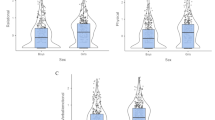Abstract
The controversy over the different natures of causal attribution of male and female IPV perpetration and victimization is examined. To examine causal attribution, limited conceptualizations (victim/perpetrator) must be replaced by a more sophisticated conceptualization taking into account both gender and individual’s involvement in violence as measured by Straus’ (2015) dyadic concordance types. Evidence is provided by the Mexican 2013 National Survey on Exclusion, Intolerance and Violence in High Schools (N = 1478). Partial support is given to the argument that IPV perpetrated by women is conceptually different from that of men because of the meanings attributed to IPV after taking into account the complexity of the dynamics in a relationship as measured by DCTs.
Similar content being viewed by others
References
Agoff, C., Rajsbaum, A., & Herrera, C. (2006). Perspectivas de las mujeres maltratadas sobre la miolencia de pareja en México. Salud Pública de México, 48(Suppl 2), S307–S314.
Agoff, C., Herrera, C., & Castro, R. (2007). The weakness of family ties and their perpetuating effects on gender violence. A qualitative study in Mexico. Violence Against Women, 13(11), 1206–1220.
Archer, J. (2000). Sex differences in aggression between heterosexual partners: A Metha-analytic review. Psychological Bulletin, 126(5), 651–680.
Arriaga, X. B. (2002). Joking violence among highly committed individuals. Journal of Interpersonal Violence, 17(6), 591–610.
Desmarais, S. L., Reeves, K. A., Nicholls, T. L., Telford, R., & Fiebert, M. S. (2012a). Prevalence of physical violence in intimate relationships, Part 1: Rates of male and female victimization. Partner Abuse, 3(2), 140–169.
Desmarais, S. L., Reeves, K. A., Nicholls, T. L., Telford, R., & Fiebert, M. S. (2012b). Prevalence of physical violence in intimate relationships, Part 2: Rates of male and female perpetration. Partner Abuse, 3(2), 170–198.
Dutton, D. G. (1994). Patriarchy and wife assault: The ecological fallacy. Violence and Victims, 9(2), 167–182.
Fernández-González, L., O’Leary, K. D., & Muñoz-Rivas, M. J. (2012). We are not joking: Need for controls in reports of dating violence. Journal of Interpersonal Violence, 28(3), 602–620. doi:10.1177/0886260512455518.
Flynn, A., & Graham, K. (2010). ‘Why did it happen?’ A review and conceptual framework for research on perpetrator’s and victims’ explanations for intimate partner violence. Agression and Violent Behavior, 15(3), 239–251.
Foshee, V. A., Bauman, K. E., Linder, G. F., Rice, J., & Wilcher, R. (2007). Typologies of Adolescent Dating Violence. Journal of Interpersonal Violence, 22(5), 498–519.
Guttmann, M. C. (1997). The ethnographic (g)ambit: Women and the negotiation of masculinity in Mexico City. The American Ethnologist, 24(4), 833–855.
Jouriles, E. N., Garrido, E., Rosenfield, D., & McDonald, R. (2009). Experiences of psychological and physical aggression in adolescent romantic relationships: Links to psychological distress. Child Abuse and Neglect, 33, 451–460.
Kernsmith, P. (2005). Exerting power or Stricking back: A gendered comparison of motivations for domestic violence perpetration. Violence and Victims, 20(2), 173–185.
Langhinrichsen-Rohling, J. (2010). Controversies involving gender and intimate partner violence in the United States. Sex Roles, 62(3–4), 179–193.
Langhinrichsen-Rohling, J., McCullars, A., & Misra, T. A. (2012). Motivations for men and women’s intimate partner violence perpetration: A comprehensive review. Partner Abuse, 4(3), 429–468.
Manusov, V., & Spitzberg, B. (2008). Attribution theory. In L. A. Baxter & D. O. Braithwaite (Eds.), Engaging theories in interpersonal communication. Multiple perspectives (pp. 37–49). Thousand Oaks: Sage.
Perry, A. R., & Fromouth, M. E. (2005). Courtship violence using couple data. Journal of Interpersonal Violence, 20(9), 1078–1095.
Renzetti, C. (1999). The challenge to feminism posed by women’s use of violence in intimate relationships. In S. Lamb (Ed.), New Versions of Victims. Feminist Struggle with the Concept (pp. 42–56). New York: New York University Press.
Straus, M. A. (2010). Thirty years of denying the evidence on gender symmetry in partner violence: Implications for prevention and treatment. Partner Abuse, 1(3), 332–362.
Straus, M. A. (2013). Dyadic types of partner abuse in the PASK project. Partner Abuse, 4(2), 232–240.
Straus, M. A. (2015). Dyadic concordance and discordance in family violence: A powerful and practical approach to research and practice. Aggression and Violent Behavior, 24, 83–94.
Winstok, Z. (2011). The paradigmatic cleavage on gender differences in partner violence perpetration and victimization. Aggression and Violent Behavior, 16, 303–311.
Author information
Authors and Affiliations
Corresponding author
Rights and permissions
About this article
Cite this article
Frías, S.M. Causal Attributions of Dating Violence Perpetration and Victimization in a National Sample of High School Mexican Students. J Fam Viol 31, 1019–1023 (2016). https://doi.org/10.1007/s10896-016-9878-z
Published:
Issue Date:
DOI: https://doi.org/10.1007/s10896-016-9878-z




